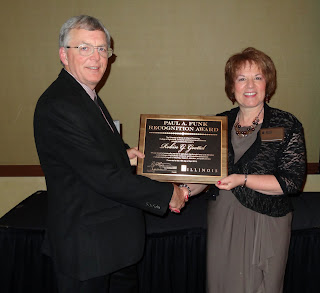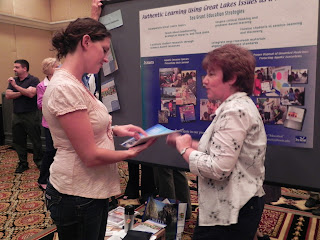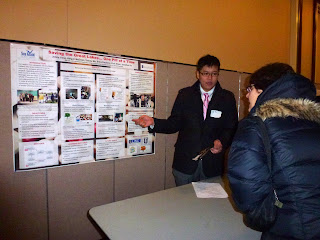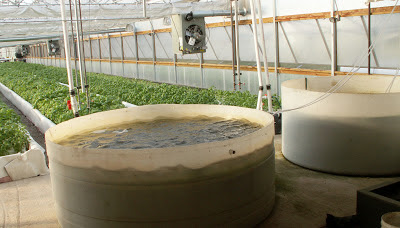August 7th, 2013 by Irene Miles
Researchers at the University of Illinois, working with the USGS and funded in part by Illinois-Indiana Sea Grant, have developed a modeling system that will help manage and prevent the spread of invasive Asian carp.
From Phys.org:
“The model, called Fluvial Egg Drift Simulator (FluEgg), follows a clutch of eggs over time as they travel downstream. Since carp spawn in turbulent waters, they seek places such as dams and spillways. To establish a large population in the Great Lakes, the carp would have to leave the lakes to spawn in the tributaries where the water moves rapidly, usually downstream from dams and spillways, where there is a lot of turbulence. The eggs have to stay suspended in the current to hatch – if they settle on the bottom, they die.
‘The challenge is, of all those million of eggs, how many of those end up hatching?’ said Marcelo Garcia, the U. of I. professor of civil and environmental engineering who led the project. ‘Our challenge has been to find a way to simulate this process from the spawning point all the way downstream. If the eggs are not kept in suspension, they will not be viable and they will die out. We have a model to look at certain streams – like tributaries to the Great Lakes – and figure out whether those streams are potential areas for Asian carp to reproduce. I think we have put together a tool that is going to be eye-opening, to say the least. It’s going to be a lot easier to visualize the transport and the conditions you need for hatching.'”
Read more about the model at the link above, and read about their outreach project here.
June 7th, 2013 by Irene Miles
With such a rainy and flood-producing spring, one’s thoughts may just turn to something practical–rain barrels. Let’s look back on last fall’s rain barrel project in Blue Island.
Illinois-Indiana Sea Grant was one of five lead partners in the “Blue Island, Blue Water” community-based program designed to reduce stormwater overflows and flooding issues in the Chicago suburb. Over the course of the project, more than 140 volunteers installed rain barrels at 33 different residential locations and three institutional buildings. Additionally, more than 1000 plants and nearly 100 trees were planted to help improve water management and beautify neighborhoods at the same time.
From the Chicagoland H2O blog:
 “Keeping water out of sewers also reduces run-off, which in turn reduces pollution in the Cal-Sag Channel. The Cal-Sag is an increasingly popular destination for Chicagoland kayakers and nature lovers, but the channel requires a strong commitment to water quality, since it runs through densely built residential and industrial areas that are potential sources of pollution. Thus, stormwater management in Blue Island represents a key effort in which ‘local, state and county governments work together to really make an impact in our neighborhoods,’ according to (zoning administrator and director of special projects Jason) Berry.”
“Keeping water out of sewers also reduces run-off, which in turn reduces pollution in the Cal-Sag Channel. The Cal-Sag is an increasingly popular destination for Chicagoland kayakers and nature lovers, but the channel requires a strong commitment to water quality, since it runs through densely built residential and industrial areas that are potential sources of pollution. Thus, stormwater management in Blue Island represents a key effort in which ‘local, state and county governments work together to really make an impact in our neighborhoods,’ according to (zoning administrator and director of special projects Jason) Berry.”
The “Blue Island, Blue Water” project was also chosen as a 2012 Millenium Reserve Model Project. The project’s inclusion also makes it part of the President’s “America’s Great Outdoors Initiative,” which helps align federal efforts and funds with conservation and recreation projects on the local level where they can make real and immediate impacts. You can learn more about the project at the links above and at this ABC 7 news report from earlier this year. And read more about the Millennium Reserve’s place within the initiative here.
April 23rd, 2013 by Irene Miles
 IISG science writer Anjanette Riley was in attendance at the University of Illinois’ Student Health Fair April 17 and sent in this post about the event.
IISG science writer Anjanette Riley was in attendance at the University of Illinois’ Student Health Fair April 17 and sent in this post about the event.
—
At a booth in the heart of the Student Health Fair held yesterday at the University of Illinois Urbana-Champaign, one important question could be heard throughout the day: If I shouldn’t flush them down the toilet, what am I supposed to do with my unused medications?
IISG’s Laura Kammin and Corrie Maxwell Layfield were there to communicate the importance of properly disposing of medicines. During the one-day event, Laura and Corrie talked with more than 130 people about the health and environmental risks posed by pharmaceutical pollution and how they could safely dispose of unwanted medicines. Visitors were also told about the nationwide medicine takeback event coming up on April 27 where they could drop off human and pet medications at locations throughout Illinois.
Amid the buzz and bustle of the crowded fair, many students lingered at IISG’s booth with additional questions about research on the effects of pharmaceuticals in water and locations of permanent collection programs. Most were surprised to learn that pharmaceutical chemicals have been found in lakes and rivers and linked with changes in wildlife behavior and health. Those who had heard of the dangers of flushing unwanted medication were also surprised to hear that pills thrown in the trash could leach into ground water or find their way to wastewater treatment plants.
But despite how much they knew about proper pharmaceutical disposal when they stopped at the booth, many left promising not to not to flush or throw away their medication in the future.
 “People get the “Don’t Flush” message,” said Kammin. “But it isn’t common knowledge yet that putting our unwanted meds in the trash just delays their trip to local water supplies. These students really got that message.”
“People get the “Don’t Flush” message,” said Kammin. “But it isn’t common knowledge yet that putting our unwanted meds in the trash just delays their trip to local water supplies. These students really got that message.”
Laura and Corrie also talked with university professors and fellow exhibitors interested in spreading the word about proper disposal. One professor wanted to incorporate pharmaceutical pollution into a class on environmental hazards. And exhibitors from health clinics and advocacy groups took IISG materials with information on collection programs and what to do when a program is not available to share with their patients and clients.
Learn more about properly disposing of unwanted medicines at our UnwantedMeds.org site, and for more information about the Drug Enforcement Administration’s National Prescription Drug Take-Back Day on April 27 including a list of locations, visit the DEA event website.
April 22nd, 2013 by Irene Miles
 |
| IISG Director Brian Miller congratulates Robin on her award |
|
Robin Goettel, Illinois-Indiana Sea Grant’s associate director for education, was recently recognized for her career-long commitment and contributions to improving natural resources.
The Paul A. Funk Recognition Award is given annually “to faculty and academic professionals for outstanding achievement and major contributions to the betterment of agriculture, natural resources, and human systems.”
Specifically, Robin’s work has extended and expanded water information and education in Illinois by introducing water science concepts, activities, curricula, and more to students and teachers throughout the state and the Midwest.
Robin was one of three people selected for this prestigious award, and the video below highlights her achievements.
April 10th, 2013 by Irene Miles
While parents, coaches, and friends gathered around to watch high school anglers show off their catch from a fishing tournament held early this week, IISG’s Sarah Zack was onsite to introduce competitors and on-lookers to simple practices that can prevent the spread of aquatic invasive species (AIS). Hosted by the Illini Bass Fishing Club, the event brought high school clubs from across Illinois to Clinton Lake on April 7 to see who could catch the most and the biggest bass. The tournament, one of few held at the high school level each year, gave IISG’s AIS outreach team an important opportunity to talk with young anglers about the threat of AIS to local waterways.
“Talking with the kids now plants that seed for future years,” said Brian Bevill, coach of the Illini Bluffs High School Bass Fishing Club.
During the few hours that IISG was onsite at Clinton Lake, Sarah talked with dozens of anglers and boaters from across Illinois. Frequent announcements from the tournament emcee also reminded the audience of the negative impacts AIS can have on the health of aquatic environments. Many of the people who visited the IISG booth had heard about Asian carp. But fewer people knew about the need to remove, drain, and dry all equipment after a day on the water. Most were also interested in learning about a new Illinois law that makes it illegal to drive with plants or mud still clinging to boats and trailers.
This High School Open is one of many fishing tournaments IISG’s AIS outreach team plans to attend this year in both Illinois and Indiana. This season especially, the team hopes to reach out to more amateur and semi-professional anglers with information about how they can prevent the spread of invasive species.
“These anglers want to make sure they’re doing their part to prevent the spread of AIS because they know that is an important part of preserving the sport of fishing for the future,” said Sarah. “It is encouraging that the message is being embraced. I was especially excited to work with the Illini Bass Fishing Club because of their commitment to AIS prevention.”
“We started this because we wanted to show kids in high school that if they care about fishing enough, and work hard enough, they can take it somewhere,” said Luke Stoner, executive administrator for the club. “What we really like to see are smiling faces and big old bass.”
This year, 134 students fought to catch the most and biggest fish. For many of the teams, the tournament marked their first day on the water this season. But after months of casting practice and learning how to “flip and pitch” the lure to trick the bass into biting, the student anglers were prepared.
Three teams brought in bags of fish weighing more than 17 lbs, and three fish came in at over 6 lbs. Their successes at this event will help students qualify to compete in sectional and state competitions slated for later this year.
“The competition in fishing is unlike any other sport,” said Kyle Sweet, a senior at Illini Bluffs High School in Glasford, IL. “In football, for example, you only play one other team at a time. Here we are competing with 67 teams and the fish at the same time.”
March 11th, 2013 by Irene Miles
Illinois-Indiana Sea Grant, along with several other Sea Grant programs, universities, and researchers, have been involved in advising and establishing a number of aquaculture operations in the U.S. and around the world, including some aquaponics facilities. This video from our friends at Purdue University provides a terrific amount of detail about aquaponics and how the process could help sustainably grow food.
With the ability to grow plants and fish in a mutually beneficial system, aquaponics presents an especially viable and sustainable option to provide healthy and locally grown food for urban areas.
From The Atlantic Cities:
“Aquaponics is a method of combined fish and vegetable farming that requires no soil. The farmer cultivates freshwater fish (aquaculture) and plants (hydroponics) in a recirculating water system that exchanges nutrients between the two. Wastewater from the fish serves as organic fertilizer for the plants, while the plants clean the water of fish feces and urine. The net result: a 90 percent reduction in freshwater use compared with conventional fish farming, and a significant reduction in added nutrients such as fossil fertilizers. The system can be run without pesticides and, because the fish environment is spacious and clean, without antibiotics…
In the lab, the pumps made gushy sounds at regular intervals. The water dripped. As the plants’ leaves evaporated moisture, I could hear the place breathe. I picked a ripe, red tomato from a vine. This lab, I sensed, could morph into an urban oasis: a lush, breathing organism inside the city. Unlike static green spaces like parks, this would be an actual farm as well as a place of tranquility in the city — not to mention a space that could generate the food to feed that city, with minimal harm to the environment or human health, just steps from residents’ tables.”
Follow the link above to the complete article, and visit our aquaculture webpage for more information.
February 4th, 2013 by Irene Miles
 SeaPerch, a program that brings underwater robotics to classrooms and demonstrates how they can be used for educational purposes, recently held a workshop at the University of Illinois Hydrosystems Laboratory. IISG’s Robin Goettel and Terri Hallesy were among the presenters and they shared a number of educational materials that teachers could combine with their classes’ underwater robots.
SeaPerch, a program that brings underwater robotics to classrooms and demonstrates how they can be used for educational purposes, recently held a workshop at the University of Illinois Hydrosystems Laboratory. IISG’s Robin Goettel and Terri Hallesy were among the presenters and they shared a number of educational materials that teachers could combine with their classes’ underwater robots.
Thirteen Champaign-Urbana science teachers were in attendance to learn how to incorporate SeaPerch underwater robots into their classroom curricula. Coordinators from Naval Sea Systems Command – Crane STEM led the morning session to introduce the SeaPerch program, provide helpful tips for constructing the complimentary robot kit each teacher received, and discuss relevant resources for classroom use. Additional robots commonly deployed for scientific applications were also highlighted.
 Over lunch, participants interacted with U of I graduate students in engineering to discuss research topics and applications for their in-class lessons. Robin and Terri shared educational resources including two COSEE Great Lakes curriculum collections, Greatest of the Great Lakes: A Medley of Model Lessons, and a Fresh and Salt activity, “I, Robot, Can Do That!”
Over lunch, participants interacted with U of I graduate students in engineering to discuss research topics and applications for their in-class lessons. Robin and Terri shared educational resources including two COSEE Great Lakes curriculum collections, Greatest of the Great Lakes: A Medley of Model Lessons, and a Fresh and Salt activity, “I, Robot, Can Do That!”
During the afternoon session, a live demonstration of the SeaPerch robot was conducted and teachers had an opportunity to operate the SeaPerch robots in the large-scale laboratory facilities.
SeaPerch is a joint program of the Office of Naval Research and the AUVSI Foundation. Visit the SeaPerch homepage to learn more about bringing underwater robotics to the classroom, and for a calendar of upcoming workshops and events.
February 1st, 2013 by Irene Miles
 The Paul A. Funk Recognition Award provides a personal award to the winner as well as funds for their department to use in support of their work benefiting natural resources and human environmental systems.
The Paul A. Funk Recognition Award provides a personal award to the winner as well as funds for their department to use in support of their work benefiting natural resources and human environmental systems.
This year, Illinois-Indiana Sea Grant’s Robin Goettel won the award for her extensive educational outreach work, including the creation of numerous curricula for science teachers and others. In particular, the Fresh and Salt curriculum, the Greatest of the Great Lakes collection of model lessons, and The Medicine Chest have helped to inform, engage, and education over 100,000 students about environmental science related to the Great Lakes.
Robin isn’t afraid to get totally immersed in her environmental education work either, as this excerpt from her nomination proves:
“No description of Robin would be complete without a mention of Zelda the zebra mussel, a ‘spokesmussel,’ as Robin describes her. Zelda is a costume that Robin is not afraid to pull out at public events. While maybe not quite ready for Disneyworld, Zelda draws a crowd. People start with a laugh, are compelled to ask questions, and end up with a better understanding of invasive species for the unconventional approach.”
Those examples don’t begin to touch on the work that Robin has engaged in throughout her many years with the program–from direct engagement with students of all grade levels, to educational displays at some of the Midwest’s biggest events, to forging partnerships with other environmental organizations to better educate, inform, and engage people in protecting and preserving natural resources.

Robin’s many years of work on environmental issues, and her dedication to fostering ever higher levels of science education for students of all ages, make her a terrific and very deserving choice for this award.
January 3rd, 2013 by Irene Miles
 The University of Illinois’ Learning in Community (LINC) program provides service-learning opportunities for students to gain hands-on experience in a variety of fields while earning course credit towards their degree. The program also gives various departments and units at the University a chance to expand their mission and get students involved in critical issues.
The University of Illinois’ Learning in Community (LINC) program provides service-learning opportunities for students to gain hands-on experience in a variety of fields while earning course credit towards their degree. The program also gives various departments and units at the University a chance to expand their mission and get students involved in critical issues. This past fall term, the LINC Program offered a Sea Grant-focused course for eight University of Illinois students where they learned about environmental threats to local and regional waterways. They designed and executed projects based on what they had learned about proper disposal of unwanted medicines.
At the conclusion of the course, students developed five activities focused on water issues, informing a larger audience about their importance and local impacts.
The projects included:
– A presentation and activity for Urbana High School’s science club students
– An article in the Green Observer and accompanying Facebook page about the importance of proper disposal of pharmaceuticals
– Placement of brochures at the McKinley Health Center in coordination with the Directors of Health Education and the Pharmacy
– A plan to spread the message about proper medicine disposal at student dormitories and to involve students in medicine collection events in 2013
The course and projects that resulted informed current University of Illinois students about important environmental issues, while giving them experience collaborating with each other, working with local organizations and businesses, and performing outreach to share the information they learned with residents of Champaign-Urbana.













